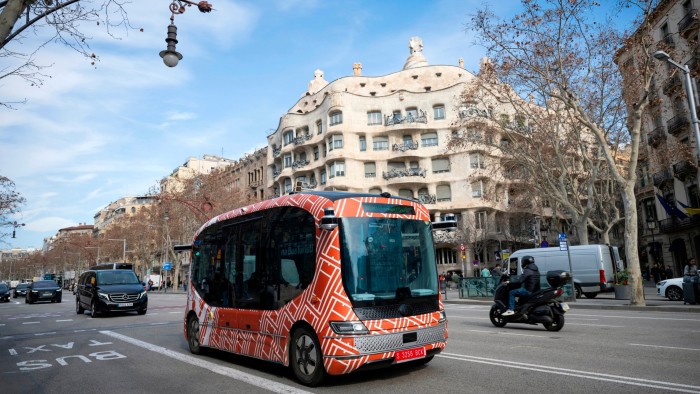Unlock the Editor’s Digest for free
Roula Khalaf, Editor of the FT, selects her favourite stories in this weekly newsletter.
Nasdaq-listed Chinese autonomous driving company WeRide has said it hopes to become profitable within five years but warned that uncertainty over international government regulation and commercial partnerships make the timing “difficult to predict”.
Tony Han, WeRide founder and chief executive, said autonomous driving required huge investment and generating returns would be a “long process”. The Nvidia-backed company has reported higher losses in each of the past three years.
“What I want in the next five years is that first of all . . . this company can become profitable,” Han told the Financial Times. “I think from a technology perspective it will definitely support this within five years, but there are more commercial and policy considerations.”
Han’s comments highlight the difficulty of monetising driverless vehicle technology. Robotaxi businesses operated by the sector’s leading companies — including Chinese internet search group Baidu and local rival Pony.ai, as well as Google’s Waymo in the US — have yet to report profits, said analysts.

WeRide, based in the southern Chinese city of Guangzhou, produces technology for a range of semi-autonomous vehicles, including sleek black taxis and curved-glass buses, as well as vans and road sweepers. In October, it raised $441.mn through an initial public offering on New York’s Nasdaq exchange and a private placement.
The company has launched limited robo-bus services in China, France, Singapore and Switzerland and is running trials of self-driving taxis in Chinese cities while partnering with Uber to offer robotaxis in Abu Dhabi. Han said he hoped to expand in other European markets, including Spain and Germany.
When WeRide becomes profitable will depend on the pace at which governments regulate driverless vehicles, public openness to the technology and how quickly partners can integrate autonomous systems, he said.
WeRide said in its IPO prospectus that its losses grew to Rmb1.9bn ($260mn) in 2023, though it said they were smaller than any listed company providing comparable self-driving technology. Annual results released this month showed losses reached Rmb2.5bn in 2024.

Lu Daokuan, an analyst at S&P Global Mobility, said high costs for software, maintenance and research were likely to prevent Chinese robotaxi groups achieving profitability until at least 2028.
He said purpose-built robotaxis were cheaper to produce and could enjoy greater economies of scale compared with self-driving taxis adapted from traditional cars. WeRide’s latest model is a purpose-built collaboration with Chinese carmaker Geely.
“Companies are also benefiting from cost reduction throughout the entire supply chain, from lidars to chips,” said Lu. “[But] full-scale commercialisation is only possible . . . when robotaxis can perform as well as human drivers on the road.”

In February, US chip giant Nvidia, a pre-IPO backer of WeRide, revealed it held a 0.68 per cent stake in the company. WeRide uses Nvidia’s graphics processors and software.
The company’s so-called level-four autonomous buses and taxis are monitored remotely, with screens showing passengers the vehicle’s map of its surroundings and its planned route. WeRide’s latest taxis still have a conventional minivan interior, but many of its buses have no driver’s booths or steering wheels.
Many of the company’s taxis, including those in Abu Dhabi and on certain roads in China, currently operate with a safety driver on board.
The company this month launched a commercial project to run its driverless buses on a relatively quiet public road in Valence, France. It also runs commercial buses with a safety driver onboard at Zurich’s airport.
The projects were generally paid for by local governments or companies they own, said Han, who was previously a professor at the University of Missouri and chief scientist at Baidu’s driverless cars unit.
He said operating costs for autonomous driving could eventually fall low enough to allow free public transport for all. “In today’s world, if you go to a park and drink the water, you don’t have to pay,” he said.


